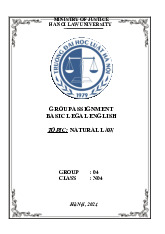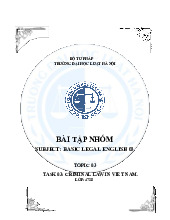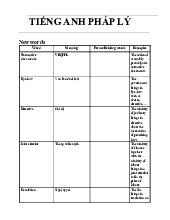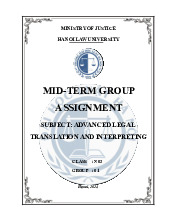












Preview text:
lOMoAR cPSD| 58412604 MINISTRY OF JUSTICE HANOI LAW UNIVERSITY GROUP ASSIGNMENT BASIC LEGAL ENGLISH 3
TOPIC: The Legal Framework for Domestic Violence in Vietnam
STUDENT’S NAME: ĐẶNG YẾN NHI-482651
ĐẶNG NHUNG NHUNG-482652
ĐÀM HÀ PHƯƠNG-482653
NGUYỄN HÀ TRANG-482665 CLASS: 4826 Hà Nội, 202 5. lOMoAR cPSD| 58412604
BIÊN BẢN XÁC ĐỊNH MỨC ĐỘ THAM GIA VÀ KẾT QUẢ
THAM GIA LÀM BÀI TẬP NHÓM Ngày: …/…/2025
Địa điểm: Trường Đại học Luật Hà Nội Nhóm số: 01 Lớp: 4826 Khoa:Luật TMQT Khoá: 48
Tổng số sinh viên của nhóm: 04 Có mặt: Vắng mặt: Có lý do: Không có lý do:
Xác định mức độ tham gia và kết quả tham gia của từng sinh viên trong việc thực
hiện bài tập nhóm với kết quả như sau: STT MÃ SV HỌ VÀ TÊN ĐÁNH GIÁ SV KÝ ĐÁNH GIÁ CỦA GV CỦA SV TÊN A B C ĐIỂM ĐIỂM GV (số) (Chữ) (Ký tên) 1 482651 Đặng Yến Nhi 2 482652 Đặng Nhung Nhung 3 482653 Đàm Hà Phương 4 482665 Nguyễn Hà Trang
Hà Nội, ngày tháng năm 2025
Kết quả điểm bài viết: ............................ NHÓM TRƯỞNG Kết quả điểm thuyết
trình:…………….
Điểm kết luận cuối cùng:……………… TABLE OF CONTENTS
A. INTRODUCTION ......................................................................................... 1
B. MAIN CONTENT .......................................................................................... 1
I. OVERVIEW OF DOMESTIC VIOLENCE IN VIETNAM ................... 1
1.Definition .................................................................................................. 1
2.Current situation of domestic violence .................................................. 1
3.Causes of domestic violence .................................................................... 2
4.Consequences of domestic violence ........................................................ 2 lOMoAR cPSD| 58412604
II. LEGAL REGULATIONS ON DOMESTIC VIOLENCE PREVENTION
IN VIETNAM .................................................................................................. 3
1.Legal Provisions in Practice ................................................................... 3
2.Assessment of practical implementation ............................................... 5
2.1. Strength ................................................................................................ 5
2.2. Limitation ............................................................................................. 6
III. PROPOSED LEGAL AND POLICY LEASURES TO ENHANCE THE
EFFECTIVENESS OF DOMESTIC VIOLENCE PREVENTION IN
VIETNAM ........................................................................................................ 7
1.Criminalization of coercive control behaviors ...................................... 7
2.Establishment of a Specialized domestic violence Court system ........ 7
3.Reform of civil and administrative remedies ........................................ 8
4.Expansion of interdisciplinary and integrated support services ........ 8
5.Integration of Gender and Conflict Resolution Education in Formal
Curricula ..................................................................................................... 8
C. CONCLUSION .............................................................................................. 9
REFERENCE LIST ........................................................................................... 9 lOMoAR cPSD| 58412604 A. INTRODUCTION
The family is often regarded as the cornerstone of society - a place where individuals
first learn about love, trust, care, and mutual respect. It is within the family that people seek
comfort, protection, and emotional support throughout their lives. However, for many, this
ideal image of family does not reflect reality. Hidden behind the walls of countless homes is
a disturbing truth: domestic violence. This form of abuse, whether physical, emotional,
psychological, or even financial, affects millions of people around the world, regardless of
age, gender, or social background. Domestic violence not only inflicts deep physical and
emotional pain on victims, but also leaves lasting damage on children, disrupts family bonds,
and undermines the very values that a healthy family is built upon. Addressing domestic
violence is not merely a matter of private concern - it is a pressing social issue that demands
our attention, action, and empathy. B. MAIN CONTENT I.
OVERVIEW OF DOMESTIC VIOLENCE IN VIETNAM. 1. Definition.
According to clause 1, article 2 of the Law on Prevention and Control of Domestic
Violence 2022: "Domestic violence is an intentional act committed by a family member that
causes or is likely to cause physical, emotional, sexual, or economic harm to another member of the family."
Domestic violence can take various forms, each causing serious harm to individuals
and families. Physical violence involves acts such as hitting, slapping, or any use of force that
causes bodily injury. Emotional or psychological violence includes verbal abuse, threats,
humiliation, and controlling behaviors that damage a person's mental well-being. Economic
violence occurs when one family member controls or restricts another's access to financial
resources, making them economically dependent. Lastly, sexual violence refers to any non-
consensual sexual act or behavior, including coercion and forced intimacy. These forms of
violence not only violate human rights but also leave long-lasting effects on victims' health and dignity.
2. Current situation of domestic violence.
A 2019 national survey in Vietnam revealed that 31.6% of women experienced at least
one form of domestic violence in the previous year, and nearly 32% suffered physical or
sexual violence by their husbands. Despite this, 90.4% of victims did not seek help, and only
4.8% contacted the police. The economic cost was significant, with domestic violence
causing productivity losses equivalent to 1.8% of GDP. lOMoAR cPSD| 58412604
In 2023, efforts to combat domestic violence showed some progress1: 74.6% of victims
received counseling, and 100% of non-criminal offenders were offered support. However,
3240 cases were still reported, mostly involving physical (1520 cases) and psychological
violence (1404 cases). There were 3193 victims, including 2628 women and 565 men.
Although the number of male victims has increased, women remain the primary victims,
accounting for over 4.6 times more than men. Of the 3208 perpetrators, 2677 were men, and
over 2900 faced legal consequences, including 129 criminal charges.
3. Causes of domestic violence.
The causes of domestic violence are diverse, but often stem from deep-rooted social,
economic, and cultural issues.
One significant factor is social evils such as drug addiction, gambling, and alcoholism.
These behaviors often lead to a loss of self-control, resulting in physical abuse, mistreatment,
and verbal humiliation of other family members.
Economic difficulties can also contribute to domestic violence. Financial stress and
instability may cause tension and frustration within the household, leading to violent
behavior. However, it is important to note that not all low-income families experience domestic violence.
Another major cause lies in individual perceptions and social norms. In some
communities, gender inequality, male dominance, and the belief that violence is a normal part
of family life still persist. These outdated and harmful mindsets continue to fuel domestic
violence, especially against women and children2.
4. Consequences of domestic violence.
Domestic violence causes severe consequences not only physically and mentally, but also
affects future generations, especially women and children.
For victims, domestic violence can result in serious injuries, long-term health issues, and
in some cases, even death. Mentally, it leads to emotional instability, anxiety, fear, depression,
and in severe cases, an increased risk of suicide. Victims often live in a constant state of insecurity and despair.
For perpetrators, domestic violence damages family relationships and can leave them with
feelings of guilt, regret, and psychological distress. More seriously, they may face
administrative penalties or even criminal prosecution depending on the severity of their actions.
1 Tạp chí Kinh tế - Tài chính, “Đẩy lùi bạo lực gia đình trên cơ sở thượng tôn pháp luật và chính sách nhất quán” tham
khảo ngày 10/4/2025, tại: https://consosukien.vn/day-lui-bao-luc-gia-dinh-tren-co-so-thuong-tonphap-luat-va-chinh- sach-nhat-quan.htm.
2 Hội Liên hiệp Phụ nữ tỉnh Nghệ An, "Bạo lực gia đình - Nguyên nhân và hướng phòng chống", tham khảo ngày
09/4/2025, tại: https://lhpn.nghean.gov.vn/chinh-sach-phap-luat/bao-luc-gia-dinh-nguyen-nhan-va-huongphong-chong- 546862. lOMoAR cPSD| 58412604
For children, whether as direct victims or witnesses, growing up in a violent household
can deeply impact their mental health and development. These children often suffer from
emotional trauma and may imitate violent behavior later in life. Many drop out of school,
engage in delinquency, or develop harmful habits such as drinking, smoking, or drug use. II.
LEGAL REGULATIONS ON DOMESTIC VIOLENCE PREVENTION IN VIETNAM.
1. Legal Provisions in Practice.
The issue of domestic violence is governed by the Law on Domestic Violence
Prevention and Control 2022. In addition, domestic violence is also addressed in various other
legal documents such as the 2015 Civil Code, the 2015 Penal Code, the 2014 Law on
Marriage and Family, and the 2004 Law on Child Protection, Care and Education.
Regarding the subjects, there are three main groups in the legal relationship concerning
domestic violence prevention and control:
First, the perpetrators of domestic violence, who can be any family members living
together such as spouses, parents, children, or other relatives - as long as their acts cause
physical or mental harm to other family members. Compared to the 2007 Law, the 2022 Law
expands the scope of subjects by recognizing acts of violence between divorced persons,
cohabiting partners, or members of extended families (e.g., stepparents and stepchildren,
former guardians). This update reflects the modern reality of increasingly diverse and complex family structures.
Second, the victims of domestic violence, who are often vulnerable individuals such
as spouses, children, the elderly, persons with disabilities, pregnant women... those who are
easily harmed physically and emotionally.
Third, agencies, organizations, and individuals responsible for domestic violence
prevention and control, including local authorities, police, women’s unions, neighborhood
representatives, and heads of institutions where incidents occur. These entities play a vital
role in identifying, preventing, and handling violent acts, as well as supporting and protecting victims.
Regarding acts of domestic violence, the 2022 Law on Domestic Violence Prevention
and Control provides a relatively comprehensive list of acts considered domestic violence,
including3: abuse, maltreatment, beating, threats, or other intentional acts that harm one’s
health or life; verbal insults, belittling, or other deliberate actions that infringe upon the
dignity and honor of individuals,… Compared to the 2007 Law, which only addressed
physical, emotional, and economic violence, the inclusion of “sexual violence” in the scope
of regulation is a necessary and significant development. This form of violence is often hidden
due to cultural norms, gender stereotypes, and dependency within marital relationships.
3 Article 3 the 2022 Law on Domestic Violence Prevention and Control. lOMoAR cPSD| 58412604
Notably, the 2022 Law clearly specifies a particular act: “coercing a spouse into
unwanted sexual intercourse,” thereby acknowledging the possibility of marital sexual
coercion—an issue that was previously dismissed due to the prevailing notion that sexual
relations between spouses were an obligation, regardless of consent. This new provision not
only reinforces the inviolable rights to bodily autonomy, dignity, and personal honor of each
individual but also aligns with the principles outlined in the CEDAW Convention and
international human rights law.
Regarding principles of domestic violence prevention, first and foremost, prevention
is identified as the core principle, with the goal of minimizing the risk of violence from the
outset. In addition, the protection of the lawful rights and interests of victims is always
prioritized, reflecting care and support for vulnerable individuals. Domestic violence
incidents must be addressed promptly, fairly, and in accordance with legal regulations, to
prevent prolonged harm and serious consequences.
Throughout the handling process, it is essential to respect the privacy of all parties
involved, avoiding any form of stigma or discrimination against victims. This approach
fosters a legal environment that is equitable, compassionate, and progressive
Regarding protective and supportive measures, the Law introduces actions such as
requiring perpetrators to report to the commune-level police where the violence occurred;
empowering commune-level People's Committee Chairs and Courts to independently issue
non - contact orders and simplifying procedures. It also provides for education and behavior
change programs for perpetrators; the “community service” measure; protection for those
involved in prevention efforts and whistleblowers; provision of temporary shelters and basic
support services. Notably, under Article 56 of the 2014 Law on Marriage and Family, a spouse
has the right to request divorce if subjected to domestic violence, showing that the law
prioritizes personal safety and dignity over marital obligations.
In addition, Article 55 of the 2022 Law on Domestic Violence Prevention and Control
amends Article 135 of the 2015 Civil Procedure Code: the Court may independently issue
temporary emergency measures under Clauses 1, 2, 3, 4, 5, and 14 of Article 114.
Accordingly, the Court may prohibit contact with the victim of domestic violence even if the
involved party does not request it. This amendment aims to promptly protect victims - many
of whom, especially women, children, or the vulnerable, may be afraid or unaware of how to
request protection. It also allows courts to proactively issue protective orders when there’s a
perceived risk, regardless of whether the victim makes a request, helping to prevent further
violence. This shift from a reactive to a proactive legal stance reflects a stronger commitment
to human rights and family protection, thereby preventing subsequent violent acts and serious
physical or psychological harm, including potentially fatal outcomes.
Regarding sanctions, current laws provide various forms of penalties.
Administratively, offenders may be fined from several million to tens of millions of VND
depending on the nature and severity of the violation. Criminally, perpetrators may be lOMoAR cPSD| 58412604
prosecuted for crimes such as abuse or mistreatment of family members4, intentional injury5,
or even murder 6in severe cases. Other legal measures include compensation for damages, community education, ect.
2. Assessment of practical implementation. II.1. Strength.
Firstly, current legal measures for the prevention and control of domestic violence in
Vietnam have made a positive contribution to reducing the number of domestic violence
cases. In 2023, notable progress was recorded in domestic violence prevention efforts, several
key indicators met or exceeded the targets set for 20256 , notable is 74.6% of individuals
subjected to domestic and gender-based violence who were identified gained access to
counseling support. According to the 2023 Report on the Implementation of National Gender
Equality Goals, there were 3122 households with incidents of domestic violence, with a total
of 3240 cases - showing a reduction of 1214 cases compared to 2022.
Secondly, legal measures for preventing domestic violence have played an important
role in providing timely support and assistance to victims. The number of victims receiving
intervention and relief has increased significantly since the enactment of relevant legal
provisions. For example, many provinces in Vietnam have effectively implemented victim-
support models for those affected by domestic violence. In Ho Chi Minh City, the National
Child Protection Hotline 111, operating 24/7, received and processed 688 calls related to
domestic violence in 2023, accounting for 55.89% of the total number of intervention cases7.
In Hanoi, the “Peaceful House” model, managed by the Center for Women and Development
under the Vietnam Women’s Union, assisted 1665 cases of women and children subjected to
domestic violence between 2020 and 20238. This model provided temporary shelter, legal
counseling, and free psychological support. Meanwhile, in Quang Tri province, local
authorities have established 54 “trusted community addresses” to serve as emergency shelters
for victims. These facilities have been promoted through 117 public awareness campaigns,
reaching over 7020 residents9. As a result, victims now have safe spaces to seek temporary
refuge. These models not only offer timely protection for victims but also serve as tangible
evidence of Vietnam’s efforts to realize the legal right to safety and assistance for individuals
subjected to violence within the family.
Thirdly, the implementation of legal provisions has contributed to raising public
awareness of domestic violence prevention, helping to reduce the number of domestic
4 Article 185 the 2015 Penal Code.
5 Article 134 the 2015 Penal Code. 6
Article 123 the 2015 Penal Code.
6 Report No. 237/BC-CP 2024 on the Government’s 2023 Results in Implementing the National Gender Equality Goals.
7 According to the 2023 report by the Department of Children.
8 Hội Liên hiệp Phụ nữ Việt Nam, “Ra mắt Trung tâm trợ giúp xã hội - Ngôi nhà Bình yên hỗ trợ phụ nữ và trẻ em bị
bạo lực”, (2023), tham khảo ngày 10/4/2025 https://www.hoilhpn.org.vn/tin-chi-tiet/-/chi-tiet/ra-mattrung-tam-tro-
giup-xa-hoi-ngoi-nha-binh-yen-ho-tro-phu-nu-va-tre-em-bi-bao-luc-60964-2.html?utm_%20.
9 Ủy ban Dân tộc, ““Địa chỉ tin cậy” góp phần đẩy lùi bạo lực gia đình trong vùng DTTS Quảng Trị”, (2025), tham
khảo ngày 10/4/2025, https://baodantoc.vn/dia-chi-tin-cay-gop-phan-day-lui-bao-luc-gia-dinh-trong-vungdtts-quang- tri-1742788226632.htm. lOMoAR cPSD| 58412604
violence. After more than a decade of enforcement of the Law on Prevention and Control of
Domestic Violence, community awareness, particularly in urban areas, has improved
significantly. Acts that were once regarded as “private family matters” are now widely
recognized as violations of the law. Media, the press, and social organizations have actively
engaged in disseminating the message that all individuals have the right to live in safety
within their own families. Effective awareness-raising campaigns have resulted in an annual
decline in domestic violence cases, contributing to social stability and the development of happy families. II.2. Limitation.
Firstly, certain legal sanctions remain ineffective and present several drawbacks.
While the law prescribes necessary sanctions for perpetrators of domestic violence, some
monetary fines appear inappropriate or impractical. For example, the act of insulting,
belittling, or offending the honor and dignity of a family member is subject to a fine ranging
from 5,000,000 to 10,000,000 VND10. However, if the offender has no income, these fines
have diminished in their deterrent effect. In another cases where the husband is unemployed,
addicted to alcohol, and physically abuses his wife and children, the question arises: “Who
will pay the fine?”. Although the law provides for enforcement measures such as asset seizure,
marital property is typically jointly owned, which complicates enforcement procedures and
may infringe upon the property rights of the non - offending spouse. As a result, in many
cases, the victim has to pay the fine on behalf of the perpetrator, which fails to punish the
offender’s behavior and discourages the victim from reporting future incidents. Similarly, in
cases where a minor aged 16 to under 18 is fined for committing violence against their parents
but lacks the financial means to pay, it is often the parents - the victims - who must pay the fine.
Secondly, the effectiveness of domestic violence awareness and prevention campaigns
remains inconsistent across different regions. In practice, the promotion of the 2022 Law on
Domestic Violence Prevention and Control at the grassroots level has been insufficient, often
integrated into other activities and yielding limited impact. The practical enforcement of
measures to address domestic violence still faces significant challenges. Many cases are not
resolved thoroughly due to various reasons, including the psychological state of victims (most
of whom are women), who may feel ashamed, fearful, resigned, or may lack a clear
understanding of their rights and the legal definition of domestic violence. Consequently, they
often refrain from reporting abuse until the situation becomes critically severe.
Thirdly, the current system of victim support facilities remains insufficient. Shelters,
counseling centers, psychosocial services, and medical care facilities are still limited in both
quantity and quality. By 2023, Vietnam had only about 425 social support facilities (both
public and private)11, a figure far too small compared to the actual needs of thousands of
victims each year. In remote and rural areas, victims face significant barriers in accessing
10 Clause 1, Article 54 of Decree No. 144/2021/NĐ-CP.
11 According to the 2022 report by the Ministry of Labour - Invalids and Social Affairs. lOMoAR cPSD| 58412604
support services due to a lack of information, geographic isolation, fear of stigmatization, or
fear of retaliation. Furthermore, although community-based models such as “Trusted
Addresses” or “Temporary Shelters” have been introduced, they often remain superficial in
operation due to funding shortages and a lack of professional personnel. These inadequacies
result in victims - primarily women and children - continuing to endure violence in silence,
without access to effective protection or refuge.
III. PROPOSED LEGAL AND POLICY LEASURES TO ENHANCE THE
EFFECTIVENESS OF DOMESTIC VIOLENCE PREVENTION IN VIETNAM.
1. Criminalization of coercive control behaviors.
A crucial legislative development would be the explicit criminalization of coercive
control within Vietnam’s penal framework. Coercive control encompasses a pattern of
behaviors including emotional manipulation, financial restriction, sexual coercion,
intimidation, and social isolation designed to dominate and regulate a victim’s autonomy,
beliefs, and conduct. Although such conduct may not manifest as overt physical violence, its
cumulative psychological impact is profound and enduring.
The United Kingdom provides a legislative precedent in Section 76 of the Serious
Crime Act 2015, which criminalizes controlling or coercive behavior in an intimate or family
relationship, punishable by up to five years’ imprisonment. Incorporating a similar provision
into Vietnamese law would represent a significant step toward harmonizing domestic
legislation with international human rights standards, particularly those concerning the
protection of women and vulnerable groups from non-physical forms of abuse.
2. Establishment of a Specialized domestic violence Court system.
To ensure swift, victim-centered adjudication of domestic violence cases, Vietnam
could consider the establishment of specialized judicial forums dedicated to handling such
matters. A comparative example can be drawn from Spain’s Gender Violence Courts
(Juzgados de Violencia sobre la Mujer), which integrate criminal, civil, and protective
jurisdiction to provide holistic and expedited relief for victims12.
Vietnam may pilot a model of specialized adjudication panels within its People’s Court
system, equipped with trained judges and legal officers to address domestic violence cases
with both procedural efficiency and a trauma-informed approach. This would contribute to
reducing secondary victimization and enhancing public trust in the judiciary’s responsiveness to gender-based violence.
12 Observatoire Européen de la Diversité, “Specialised gender violence courts in Spain”, (2021), tham khảo ngày
10/4/2025, https://www.diversite-europe.eu/en/news/specialised-gender-violence-courts-spain. 14 GoodTherapy,
“Batterer Intervention: Comprehensive Guide”, (2019), tham khảo ngày 10/4/2025
https://www.goodtherapy.org/learn-about-therapy/issues/batterer-intervention. lOMoAR cPSD| 58412604
3. Reform of civil and administrative remedies.
Beyond criminal prosecution, Vietnam’s legal response should encompass a broader
range of civil and administrative measures aimed at both victim protection and perpetrator
rehabilitation. In jurisdictions such as Germany and the Netherlands, legal frameworks allow
victims to claim non-pecuniary damages for psychological harm, in addition to material loss.
Moreover, perpetrators may be subject to restraining orders, temporary removal from
the household, or compulsory participation in behavioral intervention programs. For instance,
the Batterer Intervention Programs (BIPs) in the United States are integrated into probation
conditions and aim to alter the cognitive and behavioral patterns of offenders while ensuring
ongoing victim safety14. Vietnam could adopt a similar approach within its administrative
sanctioning regime or judicial probation mechanisms.
4. Expansion of interdisciplinary and integrated support services.
Effective prevention of domestic violence requires not only legal instruments but also
comprehensive support infrastructure. Vietnam should continue to strengthen inter-agency
coordination and invest in multi-sectoral service models, such as the “One-Stop Service
Center” implemented at Hung Vuong Hospital (Ho Chi Minh City), which offers immediate
medical, psychological, legal, and social support to victims of violence13.
Scaling up such models nationwide, with standardized protocols and interdepartmental
cooperation, would significantly enhance the accessibility and quality of victim services.
Establishing a national network of domestic violence support centers, with mandates
encompassing prevention, crisis intervention, and longterm reintegration, would further align
Vietnam’s response with international best practices.
5. Integration of Gender and Conflict Resolution Education in Formal Curricula.
Long-term eradication of domestic violence requires transformative changes in
societal norms, beginning with education. Drawing from the Swedish model, which
introduces comprehensive gender, sexuality, and emotional intelligence education across age
groups14, Vietnam should integrate curriculum-based modules on gender equality, emotional
regulation, and conflict resolution into its secondary education system.
This preventive strategy would serve to dismantle harmful gender stereotypes and
cultivate respectful interpersonal behaviors, thereby addressing the cultural roots of domestic
violence. It would also contribute to building a generation that is not only aware of legal rights
13 Nhật Anh, “Ra mắt “Mô hình một cửa hỗ trợ phụ nữ và trẻ em bị bạo lực”, (2023), tham khảo ngày 10/4/2025
https://nhandan.vn/ra-mat-mo-hinh-mot-cua-ho-tro-phu-nu-va-tre-em-bi-bao-luc-post744515.html.
14 Đ.K.L., “Hà Lan, Thụy Điển giáo dục giới tính từ... mẫu giáo”, (2017), tham khảo ngày 10/4/2025
https://tuoitre.vn/ha-lan-thuy-dien-giao-duc-gioi-tinh-tu-mau-giao-1283144.htm. lOMoAR cPSD| 58412604
and responsibilities but also equipped with the social-emotional competencies necessary for
fostering healthy familial relationships. C. CONCLUSION
In conclusion, domestic violence is a grave and deeply rooted problem that threatens
the well-being of individuals, families, and society. It strips victims of their dignity, their
sense of safety, and sometimes even their lives. The consequences extend far beyond
immediate harm - children who grow up in violent households are often emotionally scared
and may struggle with relationships and mental health well into adulthood. Breaking the cycle
of domestic violence requires a collective effort: governments must enforce strong legal
protections, communities must offer support systems and safe spaces, and every individual
must speak out against abuse in all its forms. Most importantly, we must promote a culture of
respect, equality, and nonviolence in every home. A truly loving family is not one without
conflict, but one where problems are resolved with compassion, communication, and care -
not cruelty. Only by confronting this issue head-on can we hope to create a safer, more humane world for all. REFERENCE LIST
1. The 2022 Domestic Violence Prevention and Control Law. 2. The 2015 Penal Code.
3. Report No. 237/BC-CP 2024 on the Government’s 2023 Results in Implementing the
National Gender Equality Goals.
4. The report by the Department of Children in 2023.
5. Decree No. 144/2021/NĐ-CP.
6. The report by the Ministry of Labour - Invalids and Social Affairs in 2022.
7. Tạp chí Kinh tế - Tài chính, “Đẩy lùi bạo lực gia đình trên cơ sở thượng tôn pháp luật và
chính sách nhất quán” tham khảo ngày 10/4/2025, tại:
https://consosukien.vn/day-lui-bao-luc-gia-dinh-tren-co-so-thuong-ton-phap-luatva- chinh-sach-nhat-quan.htm.
8. Hội Liên hiệp Phụ nữ tỉnh Nghệ An, "Bạo lực gia đình - Nguyên nhân và hướng phòng
chống", tham khảo ngày 09/4/2025, tại: https://lhpn.nghean.gov.vn/chinhsach-phap-
luat/bao-luc-gia-dinh-nguyen-nhan-va-huong-phong-chong-546862.
9. Hội Liên hiệp Phụ nữ Việt Nam, “Ra mắt Trung tâm trợ giúp xã hội - Ngôi nhà Bình yên
hỗ trợ phụ nữ và trẻ em bị bạo lực”, (2023), tham khảo ngày 10/4/2025
https://www.hoilhpn.org.vn/tin-chi-tiet/-/chi-tiet/ra-mat-trung-tam-tro-giup-xa-hoingoi-
nha-binh-yen-ho-tro-phu-nu-va-tre-em-bi-bao-luc-60964-2.html?utm_%20.
10.Ủy ban Dân tộc, ““Địa chỉ tin cậy” góp phần đẩy lùi bạo lực gia đình trong vùng DTTS
Quảng Trị”, (2025), tham khảo ngày 10/4/2025, https://baodantoc.vn/diachi-tin-cay-gop-
phan-day-lui-bao-luc-gia-dinh-trong-vung-dtts-quang-tri1742788226632.htm. lOMoAR cPSD| 58412604
11.Observatoire Européen de la Diversité, “Specialised gender violence courts in Spain”,
(2021), tham khảo ngày 10/4/2025, https://www.diversite-europe.eu/en/news/specialised- gender-violence-courts-spain.
12.GoodTherapy, “Batterer Intervention: Comprehensive Guide”, (2019), tham khảo ngày
10/4/2025 https://www.goodtherapy.org/learn-about-therapy/issues/battererintervention.
13.Nhật Anh, “Ra mắt “Mô hình một cửa hỗ trợ phụ nữ và trẻ em bị bạo lực”, (2023), tham
khảo ngày 10/4/2025 https://nhandan.vn/ra-mat-mo-hinh-mot-cua-ho-trophu-nu-va-tre-
em-bi-bao-luc-post744515.html.
14. Đ.K.L., “Hà Lan, Thụy Điển giáo dục giới tính từ... mẫu giáo”, (2017), tham khảo ngày 10/4/2025
https://tuoitre.vn/ha-lan-thuy-dien-giao-duc-gioi-tinh-tu-mau- giao1283144.htm.




